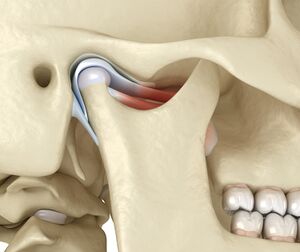Aetiology, Symptoms and Clinical Classifications of Temporomandibular Disorders
Top Contributors - Jess Bell, Wanda van Niekerk, Kim Jackson and Olajumoke Ogunleye
Introduction[edit | edit source]
The temporomandibular joint (TMJ) is considered one of the most complex joints in the body. It plays a significant role in dental occlusion and the neuromuscular system.[1]
It has been classified as both a compound joint and a double joint. Compound joints typically consist of three or more bones, but the TMJ only has two bones. Instead of a third bone, an articular disc sits between the mandibular fossa and the condyle (Figure 1).[1]
The anatomy, biomechanics and physiology of the TMJ are discussed in detail here and here.
- ↑ 1.0 1.1 Chang CL, Wang DH, Yang MC, Hsu WE, Hsu ML. Functional disorders of the temporomandibular joints: Internal derangement of the temporomandibular joint. Kaohsiung J Med Sci. 2018;34(4):223-30.







